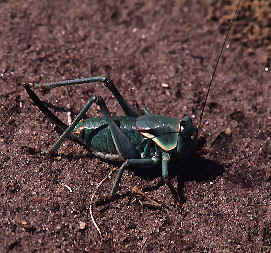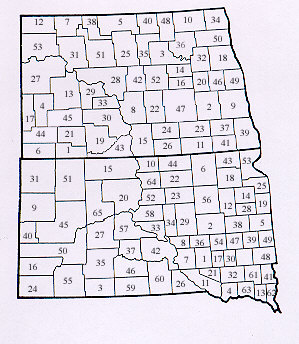
(photo Loren Oslie)
The primary purpose of this site is the identification of Orthoptera occurring in the Northern Great Plains. Every species known to occur in either North Dakota or South Dakota is included within the keys. All species recorded from North Dakota or reported from near the borders, have an additional page of characters and a map showing known distribution records. The Home page gives an overview of this website. Every topic and every page of this site is accessible through the Table of Contents. The Introduction section is simply what this site is about and how to use it. All technical terms used in the text are explained and usually illustrated in the section: Anatomy of a grasshopper. To make an accurate identification, such terms cannot be avoided. Bear in mind that each term is a ‘sign post’ that conveys the message, "What I need to see to identify this grasshopper."

(photo Loren Oslie)
The section: Distinguishing nymphs from adults, addresses the question, "Can I use the key to identify this grasshopper?" At present, the identification key used in this website only deals with adult specimens. Nymphs of many common species are pictured with adults under their appropriate species headings. Distinguishing characteristics of many additional nymphs are also included under the species headings. Because some distinctive characters are sex specific, there is a section titled: Distinguishing males from females. In a few cases, characters listed in the key only apply to one sex, additional ones are often listed under the species headings.
The main identification tool provided is the Key to the Orthoptera of the Dakotas. Rather than being a ‘traditional’ dichotomous key, here you will find groupings of species followed by a short list characters common to the group. With this system, you will always have an overview as to ‘where you are going’ and, your judgment can be based on more than one character. The first idea is important because the identification process is a descent through a succession of smaller groups– and there are many grasshopper species. The second idea is important in that not every single member of a group will have every single character. Species are not postage stamps. There is variation. See also the directions at the beginning of the key.
Identification characters for the Orthoptera of North Dakota, accessible from the table of contents, through the key, or via the species index, is a listing of every species reported from North Dakota, or found close to the borders of that state. For each entry there is: Latin and common name, diagnostic characters, range map, and often ‘thumbnail’ pictures. For economically important species, additional identification diagrams are provided.
Range maps for the Orthoptera of North Dakota are part of the identification pages. Each map records (dark blue) all counties in the Dakotas from which a specimen has been collected and is preserved in either the North Dakota State Insect Reference Collection (North Dakota State University, Fargo, ND) or the Severin-McDaniel Insect Research Museum (South Dakota State University, Brookings, SD). Counties shaded in pale blue represent published literature records– see the bibliography for sources. ‘Holes’ in maps such as these, illustrate the amount of information still not known about even our common hoppers.
By definition, every website should have a Photo gallery. If you dislike keys, worry over lists of characters, but ‘know what the critter looks like,’ this portion of the website is for you. Through the thumbnail pictures you can access the species pages and range maps.
| ND counties | SD counties | ||
| 1. Adams | 34. Pembina | 1. Aurora | 34. Hyde |
| 2. Barnes | 35. Pierce | 2. Beadle | 35. Jackson |
| 3. Benson | 36. Ramsey | 3. Bennett | 36. Jerauld |
| 4. Billings | 37. Ransom | 4. Bon Homme | 37. Jones |
| 5. Bottineau | 38. Renville | 5. Brookings | 38. Kingsbury |
| 6. Bowman | 39. Richland | 6. Brown | 39. Lake |
| 7. Burke | 40. Rolette | 7. Brule | 40. Lawrence |
| 8. Burleigh | 41. Sargent | 8. Buffalo | 41. Lincoln |
| 9. Cass | 42. Sheridan | 9. Butte | 42. Lyman |
| 10. Cavalier | 43. Sioux | 10. Campbell | 43. Marshall |
| 11. Dickey | 44. Slope | 11. Charlex Mix | 44. McPherson |
| 12. Divide | 45. Stark | 12. Clark | 45. Meade |
| 13. Dunn | 46. Steele | 13. Clay | 46. Mellette |
| 14. Eddy | 47. Stutsman | 14. Codington | 47. Miner |
| 15. Emmons | 48. Towner | 15. Corson | 48. Minnehaha |
| 16. Foster | 49. Traill | 16. Custer | 49. Moody |
| 17. Golden Valley | 50. Walsh | 17. Davison | 50. Pennington |
| 18. Grand Forks | 51. Ward | 18. Day | 51. Perkins |
| 19. Grant | 52. Wells | 19. Deuel | 52. Potter |
| 20. Griggs | 53. Williams | 20. Dewey | 53. Roberts |
| 21. Hettinger | 21. Douglas | 54. Sanborne | |
| 22. Kidder | 22. Edmunds | 55. Shannon | |
| 23. LaMoure | 23. Faulk | 56. Spink | |
| 24. Logan | 24. Fall River | 57. Stanley | |
| 25. McHenry | 25. Grant | 58. Sulley | |
| 26. McIntosh | 26. Gregory | 59. Todd | |
| 27. McKenzie | 27. Haakon | 60. Tripp | |
| 28. McLean | 28. Hamiln | 61. Turner | |
| 29. Mercer | 29. Hand | 62. Union | |
| 30. Morton | 30. Hanson | 63. Yankton | |
| 31. Mountrail | 31. Harding | 64. Walworth | |
| 32. Nelson | 32. Hutchinson | 65. Ziebach | |
| 33. Oliver | 33. Hughes | ||

Last updated: 02/08/02
Gerald M. Fauske
Research Specialist
NDSU
202 Hultz Hall
Fargo, ND 58105
E-Mail: Gerald.Fauske@ndsu.nodak.edu
Published by the Department of Entomology
Prospective students may schedule a visit by calling 1-800-488-NDSU.